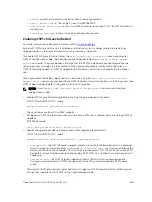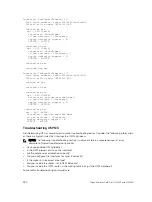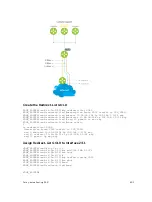
Configuring IPSec Authentication for an OSPFv3 Area
To configure, remove, or display IPSec authentication for an OSPFv3 area, use the following commands.
Prerequisite
: Before you enable IPsec authentication on an OSPFv3 area, first enable OSPFv3 globally on
Configuration Task List for OSPFv3 (OSPF for IPv6)
).
The security policy index (SPI) value must be unique to one IPSec security policy (authentication or
encryption) on the router. Configure the same authentication policy (the same SPI and key) on each
interface in an OPSFv3 link.
If you have enabled IPSec encryption in an OSPFv3 area using the
area encryption
command, you
cannot use the
area authentication
command in the area at the same time.
The configuration of IPSec authentication on an interface-level takes precedence over an area-level
configuration. If you remove an interface configuration, an area authentication policy that has been
configured is applied to the interface.
• Enable IPSec authentication for OSPFv3 packets in an area.
CONF-IPV6-ROUTER-OSPF mode
area-
id
authentication ipsec spi
number
{MD5 | SHA1} [
key-encryption-type
]
key
–
area
area-id
: specifies the area for which OSPFv3 traffic is to be authenticated. For
area-id
,
enter a number or an IPv6 prefix.
–
spi
number
: is the SPI value. The range is from 256 to 4294967295.
–
MD5 | SHA1
: specifies the authentication type: message digest 5 (
MD5
) or Secure Hash Algorithm
1 (
SHA-1
).
–
key-encryption-type
: (optional) specifies if the key is encrypted. The valid values are
0
(key is
not encrypted) or
7
(key is encrypted).
–
key
: specifies the text string used in authentication. All neighboring OSPFv3 routers must share
key to exchange information. For MD5 authentication, the key must be 32 hex digits (non-
encrypted) or 64 hex digits (encrypted). For SHA-1 authentication, the key must be 40 hex digits
(non-encrypted) or 80 hex digits (encrypted).
• Remove an IPSec authentication policy from an OSPFv3 area.
no area area-id authentication ipsec spi
number
• Display the configuration of IPSec authentication policies on the router.
show crypto ipsec policy
Configuring IPsec Encryption for an OSPFv3 Area
To configure, remove, or display IPsec encryption in an OSPFv3 area, use the following commands.
Prerequisite
: Before you enable IPsec encryption in an OSPFv3 area, first enable OSPFv3 globally on the
router (refer to
Configuration Task List for OSPFv3 (OSPF for IPv6)
The SPI value must be unique to one IPsec security policy (authentication or encryption) on the router.
Configure the same encryption policy (the same SPI and keys) on each interface in an OPSFv3 link.
NOTE: When you configure encryption using the
area encryption
command, you enable both
IPsec encryption and authentication. However, when you enable authentication on an area using
the
area authentication
command, you do not enable encryption at the same time.
If you have enabled IPsec authentication in an OSPFv3 area using the
area authentication
command, you cannot use the
area encryption
command in the area at the same time.
Open Shortest Path First (OSPFv2 and OSPFv3)
587
Summary of Contents for Z9000
Page 1: ...Dell Configuration Guide for the Z9000 System 9 7 0 0 ...
Page 80: ...grub reboot 80 Management ...
Page 128: ... 0 Te 1 1 Te 1 2 rx Flow N A N A 128 Access Control Lists ACLs ...
Page 491: ...Figure 70 Configuring OSPF and BGP for MSDP Multicast Source Discovery Protocol MSDP 491 ...
Page 496: ...Figure 73 MSDP Default Peer Scenario 1 496 Multicast Source Discovery Protocol MSDP ...
Page 497: ...Figure 74 MSDP Default Peer Scenario 2 Multicast Source Discovery Protocol MSDP 497 ...
Page 498: ...Figure 75 MSDP Default Peer Scenario 3 498 Multicast Source Discovery Protocol MSDP ...
Page 760: ...Figure 100 Single and Double Tag TPID Match 760 Service Provider Bridging ...
Page 761: ...Figure 101 Single and Double Tag First byte TPID Match Service Provider Bridging 761 ...
















































